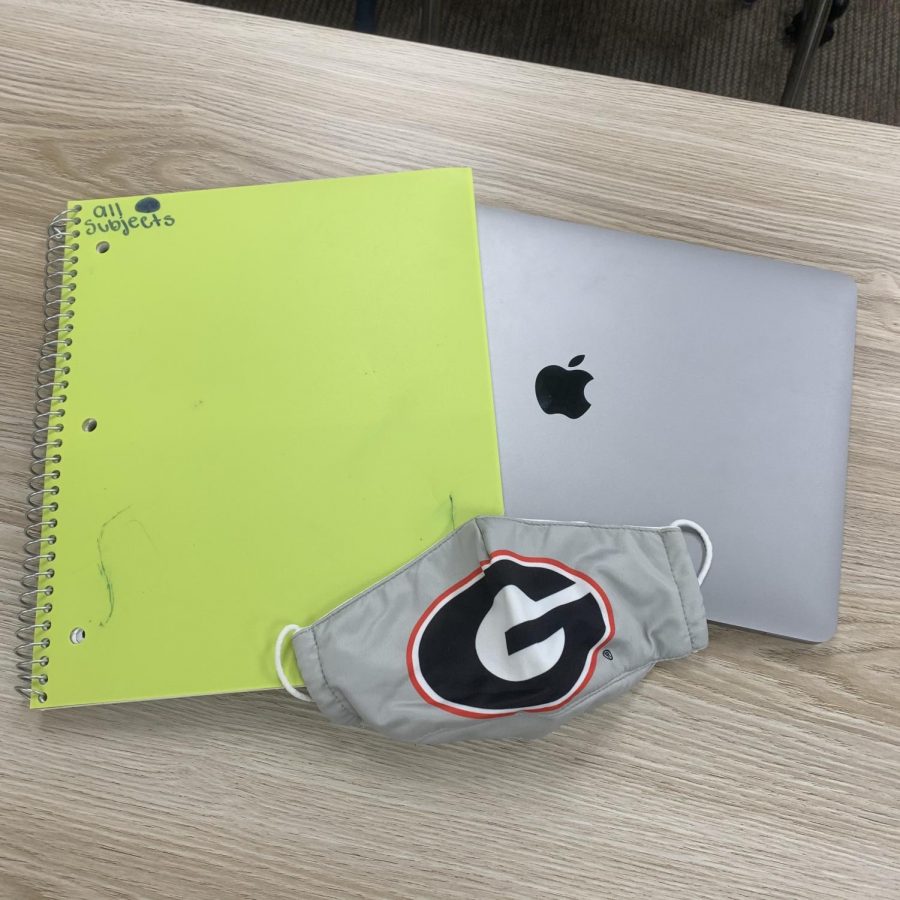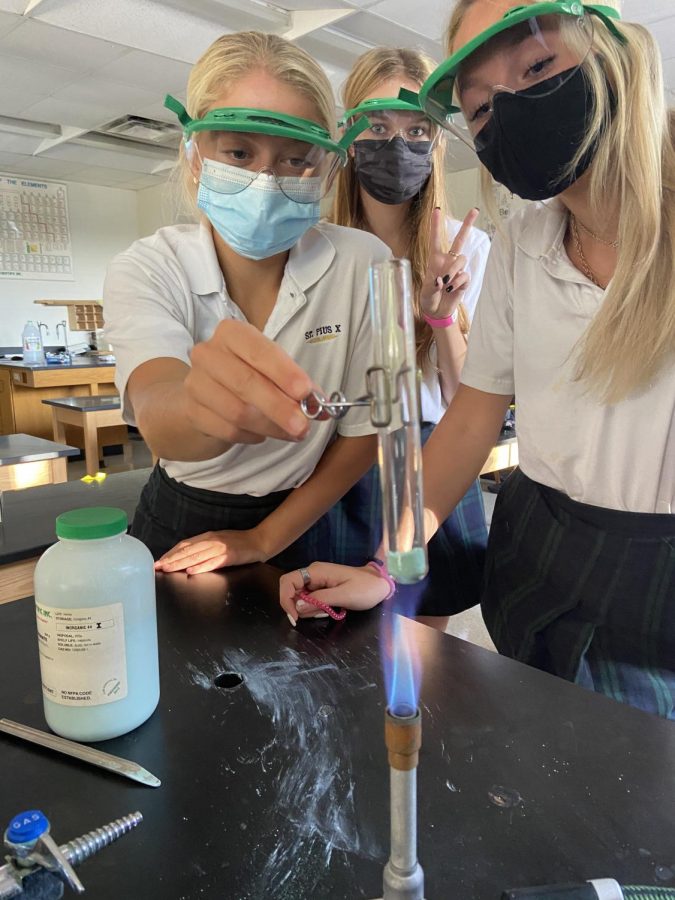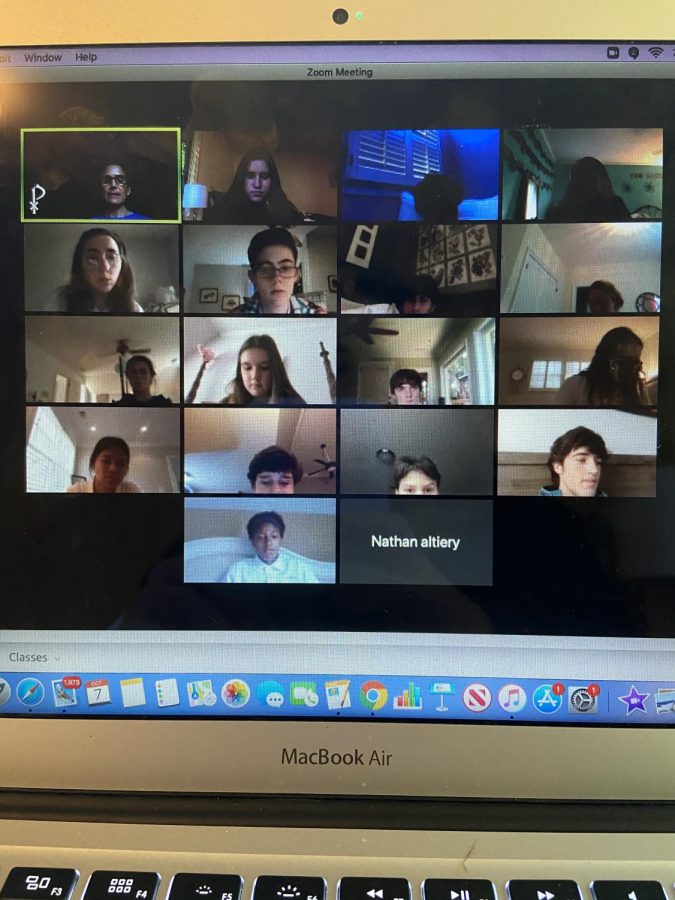
The debate between FTV and IPP
While some thrive in the virtual learning environment, others learn best when they attend school in person
December 2, 2020
In-person learning is more effective and engaging
Sophomores Julia Tiberia, Nora Tolbert, and Hadley Broughton participate in a science lab during chemistry class. Most students prefer in-person learning over virtual learning because it allows them to interact with their classmates and teachers in a more engaging way.
I wake up in the morning, change into my uniform, lace up my shoes, and race out the door clutching my backpack in one hand and my breakfast in the other. It’s like the Indy 500 on the streets as we race my brother to school and accelerate further to arrive at St. Pius on time. I jump out of the car and wave goodbye to my mom much like I have done for the past nine years, but this year is a year like no other.
I pull my stuffy mask over my nose and follow the designated path to my classroom, but no matter the discomfort, I am relieved to be in the building, relieved to be around my peers, and relieved to be back in school.
Since 1827, students have gone to school in America, from cities in New York to California to St. Pius X Catholic High School here in Atlanta… at least until COVID-19 hit.
To some capacity, St. Pius X students, teachers, and staff have been working, studying, and learning online via virtual school since March, but I find this method of learning to be unreliable, unhealthy, more stressful, and a threat to academic integrity.
This experience has been a rigorous and demanding process for not only St. Pius students but students around the world. When online, students feel that they are constantly missing something or are losing opportunities. I constantly check PSL when at home and stress about making it to Zoom online without the helpful bells and hallways of the school.
What’s even more troublesome, though, is that Zoom tends to lag, quit, or refuse to load, taking precious time away from the classroom. Students, accustomed to whiteboards, must now adjust to the extraordinary amount of screen time which is extremely unrealistic.
For example, on August 24, Zoom crashed, leaving thousands of students without access to learning; this is simply too unreliable. What is not unreliable, on the other hand, is a physical classroom.
In addition to being almost foolproof, in person classes are simply more beneficial for students, and health experts back it up.
Dr. Anthony Fauci, leading coronavirus advisor, argued. “The default position should be that we should always try to get the children back to school because of the well-known deleterious consequences of children not being allowed to go back to school.”
Even some veteran teachers feel disgruntled and out of place without a physical presence to control their students.
“The best expression I’ve heard is that this is every teacher’s ‘first year’ of teaching,’” said sophomore history teacher Mrs. Rebecca Rose. “None of us have ever taught this way before.”
In the past technology was used to enhance lessons, but in this virtual world we are now overwhelmed by our dependence on it.
Not only is teaching from a distance new, but it is also hard.
While some students do excel under virtual learning, it takes tremendous amounts of self-discipline and work ethic to succeed. Students don’t have teachers available to monitor nor are they under the same level of supervision and scrutiny. Personally, I find it difficult to stay motivated and concentrate at home.
It is all too easy to fall down the social media rabbit hole and all too hard to stare at a computer screen all day. It is simply not healthy for young people to stare into a screen for eight hours of the day. A common misconception with virtual school is that it is “easy,” but it is tremendously difficult to keep up with teachers in an environment which is not conducive to learning.
Sophomore Chloe Dierkes agreed.
“I feel that I learn better in person. In person, I have to be engaged because the teacher sees you and I’m right there,” she said.
Not only do students learn better in classrooms, but it is much easier to maintain academic integrity under the watchful eye of the teacher.
A study from the New York Times stated that 5% of in-person students were caught cheating while only 2% of the online population was caught cheating.
Why is that number cut in half? Because cheating while online is simply too easy.
The answers are one click of a mouse, flip of a flashcard, or excerpt of an open textbook away at home. The temptation is all too prevalent there is no one over your shoulder, just you, your computer, and an empty room…
Students learn better, are more engaged with their peers, and can maintain a higher level of academic integrity in person. IPP is not a political debate or an opinion; instead, it is a necessary part of being a student in America.
Students should be in person, and thankfully St. Pius is facilitating this opportunity.
Virtual learning has so many benefits
Students attend Advisory from home one day in October. While most embraced the opportunity to return to school in person every day, others opted to remain at home and prefer virtual learning.
It is the first day of my senior year. I wake up and put my senior sweatshirt on, both excited and sad for my last year of high school. I have abandoned my skirt and saddle shoes for sweatpants and bare feet. I sit down at my desk, open my computer, and log into Zoom to start my day. Never would I have thought that I would be sitting in my room and learning through a screen on my last first day of high school.
With a year like no other due COVID-19, people around the world have had to make notable adjustments to their daily lives to maintain a code of health and safety. As we are no exception to this rule, our school community has developed measures to ensure the safety of our students, faculty, and staff.
A large part of this was implementing a schedule that falls in line with health guidelines by limiting the number of students within the building each day. The administration came up with a plan to have different populations of students present on campus each day. Two tracks were created, one titled “full-time virtual learning” and the other called “in-person learning.” Full-Time Virtual students stay at home every day of the week, while members of the in-person population come to school on their designated days. Students were able to choose which population best fits their needs and safety at various points in the year.
Over the course of two months, the population of in-person students has shifted from ⅓ of the students entering school once a week to ½ of the student body attending school every other day. But, presenting itself as a negative solution, particularly for incoming freshman students who had never entered the campus and seniors who will be experiencing their last year of high school, many saw this plan of virtual learning as a negative addition to the school year. Because of this, some students struggled with the decision, as the safety of themselves and their families was at the forefront of their minds.
But, though many people saw this as negative, I, among others, was excited to participate in full-time virtual learning, despite it being my senior year. Though the idea has proven to be a change, I decided to make the best of it and explore the positive factors that have come along with virtual learning.
When deciding on whether to participate in virtual learning, the first thought was for the wellbeing of both myself and the people that I encounter on a daily basis. The same can be said for a large portion of full-time virtual students, one being senior Deaja Dunbar.
“I decided to pursue full-time virtual learning because I felt that it was the safest option for me. I did not trust that students would follow the safety guidelines,” Dunbar said.
With this thought in mind, some students decided to stay home and embrace their newfound schedule for virtual school. For me, online school has largely impacted my schedule in a very positive way. Most days, I wake up around 7:45 for my first class at 8 AM. I can hop out of bed and walk over to my desk rather than take the 15-minute drive to school and walk from Senior Lot. Many others have experienced this change in schedule, including senior Betania Kassahun.
“The biggest benefit to online learning is probably the fact that I don’t have to wake up at 5:30 A.M. anymore to get to school on time. I live 20-45 minutes away from school and before online learning, I would have to leave the house by 6:45 A.M. in order to be early for classes. Now, I wake up at 7:15 and have plenty of time to get ready for class,” Kasshun noted.
Dunbar seconded this statement saying that “My morning routine has been so much easier. I now wake up 2 hours later than beforehand which makes school so much better because I feel more well-rested.”
With large adjustments in schedule also comes large adjustments in class structure. While some students are in the classroom, students at home participate in classes via zoom Personally, I like zoom, as it allows me to feel more comfortable and provides me with a space that suits my learning style better.
“I enjoy zoom calls because I get to relax instead of sitting in a hard plastic chair all day,” senior Betania Kasshun noted. With an environment of her choosing, she has emphasized the need for a workspace that reflects your needs, which is exactly what full-time virtual learning provides.
Furthermore, my classes at home feel less stressful, despite my schedule that is largely full of challenging classes. Being at home and tuning in via zoom provides a less stressful work environment, particularly because I do not have to be in school and walk from class to class and that I have an environment of my choosing to engage in my work. Normally, I sit at my desk, with my “Starry Night” painting lining the wall, my color-coded highlighters and pens in front of me, and my peace sign lamp that lights the room in a light yellow color.
The same can be said for Dunbar, as she has created a unique environment as well.
“While at home I have created an amazing environment,” Dunbar says. When I’m at home I have the freedom to be comfortable to not worry about my space being invalidated.”
In regards to learning, many people question the ability of Full-Time Virtual students to learn at home, as it takes a large amount of self-discipline to be able to stay on task and keep up with assignments at home. But, many full-time virtual students have debunked this claim, including myself.
Because of my ability to structure my days, I can keep up with my assignments and actively engage in learning on a daily basis. I try to keep a schedule so that I am able to complete my homework each night, study for tests and quizzes, and prepare for seminars and presentations. In addition to this, I actively work to stay engaged with my classes by taking notes, asking questions, and participating in office hours that teachers hold.
Many students find office hours to be very helpful, notably Kassahun, a student who largely takes advantage of this opportunity.
“ I am still able to learn online because my teachers hold office hours where we can join and ask any questions that we have. Some teachers are very understanding when it comes to online learning, though there have been some issues,” Kassahun said.
Moving forward, the administration has allowed students to come back to school full-time, five days a week for 8 hours each day. Many students are very excited about this due to the opportunity to interact with the entirety of the student body and the return to a sense of normalcy in such chaotic times. But, full-time virtual students are again posed with the question of returning to school.
I for one will not be returning to school due to my positive experience with virtual school and my desire to protect my health. Contrary to a somewhat popular belief, I believe that online school provides a less stressful environment, positive changes to my daily routine, and a unique learning style that benefits me directly.
With an uncertain future ahead of us, it will be interesting to see which path that students pursue. Though In Person Learning has positive qualities, overall I believe that virtual learning is the way to go.

